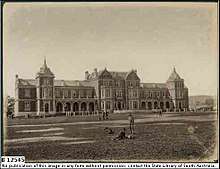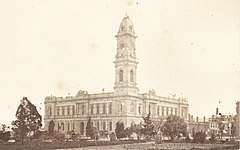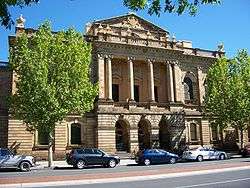William McMinn
William McMinn (1844–14 February 1884) was an Irish-born Australian surveyor and architect, based in Adelaide.
Early life
McMinn was born in Newry, County Down, Ireland, a son of Joseph McMinn (c. 1794 – 6 April 1874) and his wife Martha McMinn, née Hamill (c. 1805 – 13 December 1861), who with their large family emigrated to Adelaide on the Albatross, arriving in September 1850.[1] Newspaper reports only mention Mrs McMinn and 8 children aboard Albatross.[2]
No details of his (or his brothers') schooling are known,[1] though it has been asserted that he was taught by one Mr McGeorge of Adelaide,[3] however no teacher of that or similar name has yet come to light. It is likely the youngest children were home-educated, with the boys receiving tuition in drafting and surveying from a tutor.
Career
After completing school, he was articled to the architect James Macgeorge, and was appointed to the Architect-in-Chief's office, but in April 1864 left for employment as a chainman in Boyle Travers Finniss's 1864–65 expedition to Northern Australia surveying the area around Escape Cliffs and the Adelaide River. Following a breakdown of morale in the settlement, McMinn and six others (Stow, Hamilton, Hake, Edwards, White, and Davis, the last two being boatmen) purchased a 23-foot open boat which they dubbed the Forlorn Hope and sailed it 2,000 miles (3,200 km) to Champion Bay, near Geraldton, Western Australia.[4]
In late 1870 or early 1871 he was appointed as overseer of construction of the Overland Telegraph section from Port Augusta to Darwin, and on 3 May 1871 cancelled the contract tendered by Darwent & Dalwood, they having fallen behind schedule due to heavy rain. Critics of his action pointed out that with the onset of the dry season and better logistics this loss could easily have been made up. The work was put in the hands of engineer R. V. Patterson with instructions to finish the line by early 1872 no matter what the cost. McMinn was dismissed shortly after his return to Adelaide in July 1871, and William T. Dalwood was later awarded compensation of £11,000.[1]
McMinn began practising as an architect in 1867, briefly in partnership with Daniel Garlick,[5] and later with some others, but usually independently. He designed many grand private residences, but also designed or assisted in the design of many of Adelaide's grand public buildings. Whilst in partnership with Edward John Woods, he designed the original Venetian Gothic building (later designated the Mitchell Building)[1] of the University of Adelaide, considered his greatest work.[6]
Family
William McMinn (1844–1884) married Mary Frances Muirhead (1853–1929) at Glenelg on 14 March 1877; their family included:
- Mary Muirhead McMinn (27 January 1878 – 1957) married Charles Arthur Johns (1871–1956) in 1913
- Eileen Gordon McMinn (1879– ) married Rev. Harvey Langford Ebbs (1914–1987) on 31 August 1904
They had a home "Rutherdale" in Lower Mitcham.
McMinn had five sisters and two brothers in South Australia
- Susanna Draper McMinn (c. 1829 – 2 February 1872) married Luke Michael Cullen ( – c. 25 November 1880), solicitor of Cullen & Wigmore in 1851. He was noted for shady and corrupt practices.[7][8]
- Mary McMinn (c. 1830 – 6 October 1918) arrived separately in July 1850 aboard Sultana, married William Brewer (c. 1812 – 30 December 1877) in 1857, lived in Kapunda
- Eliza Anna Brewer (died 1918?) married John Rudall (died 1897) in 1864; married James Bray in 1899
- Annie Josephine Brewer (born 1864) married David McIntosh Cameron in 1885
- Mary Hamill Brewer (born 1866) married Mayoh Miller in 1886, lived Avoca Station, New South Wales
- Frank Ernest Brewer (Born 21 Feb 1859) Married (6 June 1882) Rose Jane Hammond (b 26 July 1861) , Lived In Adelaide and Fremantle WA
- Jane McMinn (30 September 1831 – c. June 1914) married F. S. (Frederick Simeon) Carus Driffield (c. 1828 – 18 June 1889) on 22 January 1856
- Three unmarried sisters: Sally or Sallie, Martha, and Elizabeth R. "Lizzie" McMinn (c. 1840 – 26 December 1937) ran a small school for girls from the family home, then in February 1884 founded Tormore House School, North Adelaide, which they ran for 13 years. They left for England on 15 December 1897, retiring to "Wolverton Gardens" in Ealing.
- Gilbert Rotherdale McMinn (1841–1924), worked as a surveyor on the Overland Telegraph Line, in February 1871 discovering Simpsons Gap, which proved a better route for the line. He served in various senior public service positions in the Northern Territory. McMinn Street, Darwin is named for him.
- Joseph McMinn (c. 1846 – 9 February 1888) married Charlotte Isabella "Chatty" Wells (1856– ) of Penola, was also a surveyor on the Overland Telegraph,[1][9] later in charge of Willowie State forest, Wilmington, South Australia, where he died.
- William D'Urney McMinn (1884– ) married Clarice Duck (died 6 May 1938) at Rosedale, Victoria on 15 March 1917 and had a large family
Major works
Architect
- The Mitchell Building at the University of Adelaide (1878)
- The Governor's residence at Marble Hill (1878)[10]
 The Adelaide Children's Hospital (1878)
The Adelaide Children's Hospital (1878)
- The Austral Hotel in Rundle Street
- Torrens Park (now Scotch College, Adelaide)[12]
Assistant
 The main building at Prince Alfred College (1867)
The main building at Prince Alfred College (1867) The General Post Office (1867)
The General Post Office (1867) The Supreme Court of South Australia, alterations (1869)
The Supreme Court of South Australia, alterations (1869)
References
- Geoffrey C. Bishop (2015). "Architects of South Australia: McMinn, William". Architecture Museum, University of South Australia. Retrieved 19 March 2019.
- "Shipping Intelligence". The Adelaide Times. II (251). South Australia. 14 September 1850. p. 5. Retrieved 20 May 2019 – via National Library of Australia.
- "From the metropolis". The Narracoorte Herald. IX (717). South Australia. 14 November 1884. p. 2. Retrieved 18 May 2019 – via National Library of Australia.
- "William McMinn biography at Design and Art Australia Online". Retrieved 25 October 2014.
- "General News". The Express and Telegraph. VI (1, 519). South Australia. 11 December 1868. p. 2. Retrieved 26 May 2017 – via National Library of Australia.
- Berry, Dean W. (1979). "Bagot, Walter Hervey (1880 - 1963)". Australian Dictionary of Biography. Melbourne University Press. ISSN 1833-7538. Retrieved 1 February 2009 – via National Centre of Biography, Australian National University.
- "Latest Shipping". The Evening Journal (Adelaide). XII (3622). South Australia. 26 November 1880. p. 2. Retrieved 20 May 2019 – via National Library of Australia.
- "The Bench and the Bar". The Evening Journal (Adelaide). XII (3544). South Australia. 26 August 1880. p. 2. Retrieved 20 May 2019 – via National Library of Australia.
- "Personal". The Advertiser (Adelaide). LXI (18, 727). South Australia. 21 October 1918. p. 6. Retrieved 20 May 2019 – via National Library of Australia.
- Marble Hill, Postcards
- Mount Breckan, home of the Hay Family in Victor Harbor
- Prest, Wilfrid; Round, Kerrie; Fort, Carol S. (2001). Wakefield Companion to South Australian History. ISBN 9781862545588. Retrieved 25 October 2014.
Further reading
- "McMinn, William (1844–1884)". Australian Dictionary of Biography. Published first in hardcopy MUP, 1974, volume 5. Australian National University. Retrieved 20 July 2019.CS1 maint: others (link)